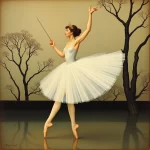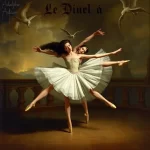Ballet: Daphnis et Chloé (Maurice Ravel, 1912)

Introduction
Daphnis et Chloé is a ballet composed by Maurice Ravel, choreographed by Michel Fokine, and premiered on June 8, 1912, by the Ballets Russes at the Théâtre du Châtelet in Paris. This one-act ballet, based on the ancient Greek romance by Longus, tells the story of the love between the goatherd Daphnis and the shepherdess Chloé, set against a backdrop of pastoral beauty and mythological elements.
Historical Background
Creation and Development
The early 20th century was a period of significant artistic innovation and cross-cultural influences. The Ballets Russes, founded by Sergei Diaghilev, was at the forefront of this movement, bringing together some of the most talented artists, composers, and choreographers of the time. Maurice Ravel, a prominent French composer known for his impressionistic style, was commissioned to create the score for Daphnis et Chloé.
The inspiration for the ballet came from the ancient Greek novel Daphnis and Chloé by Longus, a pastoral romance that had captivated audiences for centuries. The collaboration between Ravel and Fokine was marked by a shared vision of creating a work that combined music, dance, and visual art into a cohesive and immersive experience.
Premiere and Reception
Daphnis et Chloé premiered on June 8, 1912, at the Théâtre du Châtelet in Paris. The initial reception was mixed, with some critics praising the innovative score and choreography, while others found it overly complex and difficult to follow. Despite this, the ballet quickly gained recognition for its artistic merit and has since become a staple in the ballet repertoire.
Notable early performances included revivals by the Ballets Russes and other major ballet companies, solidifying its place in the history of dance.
Synopsis of the Ballet
Daphnis et Chloé is a one-act ballet divided into three tableaux, each depicting different aspects of the story.
Tableau I
The ballet opens with a pastoral scene where Daphnis and Chloé are introduced. They are surrounded by other shepherds and shepherdesses, celebrating the beauty of nature. The couple’s love is evident, but their happiness is threatened by the arrival of a group of pirates who kidnap Chloé.
Tableau II
In the second tableau, Chloé is held captive by the pirates. She prays to the god Pan for rescue. Her prayers are answered when Pan intervenes, causing a storm that frightens the pirates and allows Daphnis to rescue her.
Tableau III
The final tableau depicts the reunion of Daphnis and Chloé. They express their love through a series of dances, culminating in a grand celebration with the other shepherds and shepherdesses. The ballet concludes with a sense of harmony and joy, symbolizing the triumph of love over adversity.
Musical Composition
Composer’s Role
Maurice Ravel’s contribution to Daphnis et Chloé is one of his most significant works. The score is known for its lush orchestration, intricate harmonies, and innovative use of rhythm and texture. Ravel’s music not only supports the narrative but also enhances the emotional depth and atmosphere of the ballet.
Musical Themes and Motifs
The score of Daphnis et Chloé features several recurring themes and motifs that represent different characters and emotions. For example, the love theme associated with Daphnis and Chloé is tender and lyrical, while the music for the pirates is more aggressive and dissonant. Ravel’s use of leitmotifs helps to unify the ballet and create a cohesive musical narrative.
Famous Recordings and Performances
There have been numerous recordings of Daphnis et Chloé, with some of the most iconic conducted by Charles Munch, Pierre Monteux, and Leonard Bernstein. These recordings have helped to popularize the ballet’s music and bring it to a wider audience.
Choreography and Dance
Choreographer’s Vision
Michel Fokine’s choreography for Daphnis et Chloé was groundbreaking in its integration of classical ballet with more naturalistic and expressive movements. Fokine aimed to create a seamless blend of dance and drama, where every gesture and movement contributed to the storytelling.
Signature Dance Numbers
One of the most memorable dance numbers in Daphnis et Chloé is the Pas de Deux between Daphnis and Chloé in the final tableau. This dance encapsulates their love and joy, with intricate lifts and partnering work that highlight their connection. Another key scene is the Bacchanale, a lively and exuberant dance that celebrates the couple’s reunion.
Notable Interpretations
Over the years, different productions of Daphnis et Chloé have brought their own interpretations to the choreography. Some have emphasized the classical elements, while others have explored more contemporary or abstract styles. Notable choreographers who have reinterpreted the ballet include Frederick Ashton and John Neumeier.
Characters and Roles
Main Characters
- Daphnis: A young goatherd who falls in love with Chloé. He is brave, kind, and deeply devoted to her.
- Chloé: A shepherdess who shares a mutual love with Daphnis. She is gentle, pure, and resilient.
Supporting Characters
- Pan: The god who intervenes to save Chloé from the pirates.
- The Pirates: Antagonists who kidnap Chloé and threaten her happiness with Daphnis.
Famous Dancers
Notable dancers who have portrayed Daphnis and Chloé include Vaslav Nijinsky and Tamara Karsavina in the original production, as well as more recent performers like Roberto Bolle and Alina Cojocaru.
Cultural and Artistic Impact
Influence on Ballet and Dance
Daphnis et Chloé has had a lasting impact on the world of ballet and dance. Its innovative choreography and music have inspired countless other works and choreographers. The ballet’s emphasis on integrating dance with narrative and emotion has influenced the development of modern ballet.
Cultural Significance
The ballet’s themes of love, nature, and myth have resonated with audiences and artists alike. Daphnis et Chloé has been referenced in literature, film, and other art forms, highlighting its enduring cultural significance.
Legacy and Revivals
Daphnis et Chloé continues to be performed and celebrated today. Major revivals by companies like the Paris Opera Ballet and the Royal Ballet have kept the ballet alive for new generations of audiences. Modern adaptations and reinterpretations have also ensured its relevance in contemporary dance.
Iconic Productions
Historic Productions
The original 1912 production by the Ballets Russes is one of the most famous historical productions of Daphnis et Chloé. Key figures involved included Sergei Diaghilev as the director, Léon Bakst as the set and costume designer, and Vaslav Nijinsky and Tamara Karsavina as the lead dancers.
Contemporary Productions
Recent productions of Daphnis et Chloé have brought new interpretations to the ballet. For example, the Paris Opera Ballet’s 2014 production featured updated choreography by Benjamin Millepied, while still honoring the original vision of Fokine and Ravel.
Production Design
The set, costume, and lighting design in various productions of Daphnis et Chloé have played a crucial role in bringing the story to life. Léon Bakst’s original designs were known for their vibrant colors and intricate details, creating a visually stunning backdrop for the ballet. Modern productions have experimented with different design elements, from minimalist sets to elaborate digital projections.
Critical Reception and Reviews
Initial Critical Response
At the time of its premiere, Daphnis et Chloé received mixed reviews. Some critics praised the innovative score and choreography, while others found it overly complex and difficult to follow. Despite this, the ballet quickly gained recognition for its artistic merit.
Modern Reviews
Contemporary critics and audiences generally view Daphnis et Chloé as a masterpiece of early 20th-century ballet. The ballet is praised for its emotional depth, innovative choreography, and lush musical score. Its enduring popularity is a testament to its significance in the history of dance.
Fun Facts and Trivia
Behind-the-Scenes Stories
One interesting anecdote from the original production involves Vaslav Nijinsky, who played Daphnis. During rehearsals, Nijinsky’s intense dedication to his role led him to practice for hours on end, often to the point of exhaustion. His commitment to the character contributed to the ballet’s success.
Notable Performers
In addition to Nijinsky and Karsavina, other famous dancers associated with Daphnis et Chloé include Margot Fonteyn, Rudolf Nureyev, and Mikhail Baryshnikov. These performers have brought their own unique interpretations to the roles, adding to the ballet’s rich history.
Trivia
- Maurice Ravel considered Daphnis et Chloé to be one of his greatest works.
- The ballet’s score includes a famous “Daybreak” section, which is often performed as a standalone orchestral piece.
- The original production featured elaborate sets and costumes designed by Léon Bakst, known for his work with the Ballets Russes.
Conclusion
Summary of the Ballet’s Importance
Daphnis et Chloé is a significant work in the world of ballet, known for its innovative choreography, lush musical score, and emotional depth. The collaboration between Maurice Ravel and Michel Fokine resulted in a masterpiece that continues to captivate audiences and inspire artists.
Final Thoughts
Reflecting on Daphnis et Chloé, it is clear that the ballet’s themes of love, nature, and myth have a timeless appeal. Whether experienced through a live performance or a recording of Ravel’s score, Daphnis et Chloé offers a rich and immersive artistic experience. For those who have not yet had the opportunity, watching a performance or listening to the music is highly recommended.
FAQ
What is the central theme of this ballet?
The central theme of Daphnis et Chloé is the triumph of love over adversity, set against a backdrop of pastoral beauty and mythological elements.
Who are the main characters in this ballet?
The main characters are Daphnis, a young goatherd, and Chloé, a shepherdess. Their love story is central to the ballet’s narrative.
What is the most famous dance number in this ballet?
The Pas de Deux between Daphnis and Chloé in the final tableau is one of the most famous dance numbers in the ballet, showcasing their love and joy.
How long does a typical performance of this ballet last?
A typical performance of Daphnis et Chloé lasts approximately one hour, as it is a one-act ballet.
Are there any modern adaptations of this ballet?
Yes, there have been several modern adaptations and reinterpretations of Daphnis et Chloé, including productions by the Paris Opera Ballet and other major companies.
Why is this ballet considered important in the history of dance?
Daphnis et Chloé is considered important for its innovative choreography, lush musical score, and emotional depth. It has had a lasting impact on the development of ballet and continues to inspire artists and audiences alike.





